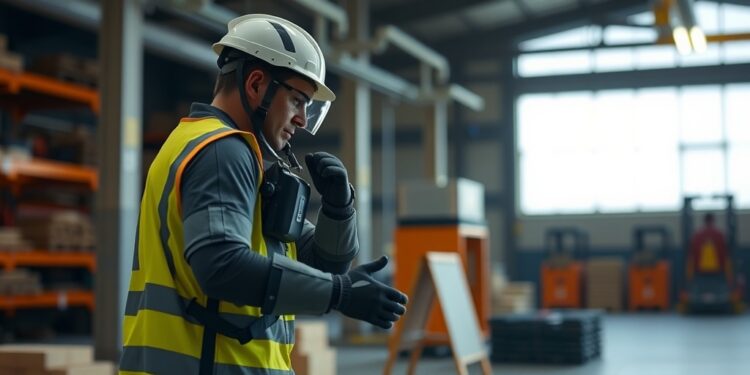In a groundbreaking advance in robotics, recent research published in the esteemed journal Advanced Intelligent Systems has unveiled a novel soft wearable robot designed to assist workers in mitigating job-related injuries while engaging in physically demanding tasks. This development comes at a crucial time as workplace injuries, particularly those associated with manual handling, continue to be a significant concern globally. The innovation is poised to revolutionize the way employees approach lifting, lowering, and carrying objects, potentially reducing the risk associated with these activities.
The wearable robot, aptly named WeaRo, distinguishes itself from its predecessors through its multifaceted design, enabling movement across multiple degrees of freedom. Traditional wearable robots typically support only a single degree of freedom, limiting the range of motion at various joints. WeaRo’s sophisticated mechanism allows for a more dynamic range of motion, which is essential for performing complex tasks that require flexibility and adaptability. By accommodating diverse body movements and postures, WeaRo addresses one of the key limitations posed by older models, making it a versatile assistant in various manual handling scenarios.
Dr. Dongjun Shin, a prominent figure in this research and a faculty member at Yonsei University in the Republic of Korea, emphasized the significance of this study. He stated that the development of WeaRo signifies a comprehensive approach that blends movement analysis with practical robot design and effectiveness validation. This methodology is crucial in addressing the growing concern of work-related injuries resulting from strenuous physical labor. By focusing on the ergonomic aspects of robot design, the team has successfully created a tool that not only supports but enhances the worker’s capability to perform tasks safely.
The soft robotic design of WeaRo is one of its most remarkable features. Unlike traditional rigid robots, this innovative creature utilizes flexible materials that allow it to move and adapt to the user’s actions seamlessly. This flexibility is critical as it reduces the jarring movements often associated with lifting devices and enhances user comfort. The overall weight of WeaRo, which is kept under 11.5 pounds (5.2 kg) including batteries, further bolsters its usability, allowing workers to wear it for extended periods without fatigue.
The implications of such technology extend beyond individual workplaces. As industries continue to seek ways to increase productivity while ensuring employee safety, wearable robotics like WeaRo could play a pivotal role. By minimizing physical exertion and the accompanying risk of injury, companies could see a decrease in health-related absences, thus enhancing productivity and reducing operational costs.
Research surrounding WeaRo is not merely a solitary endeavor; it aligns with a broader trend in the field of robotics that emphasizes collaborative human-robot interaction. By augmenting human potential rather than replacing it, WeaRo embodies the ideal of synergy between human capabilities and robotic enhancements. This is particularly vital in environments that demand high levels of manual labor, where the combination of endurance and efficiency can lead to significant improvements in operational performance.
The introduction of such advanced robotics necessitates further exploration into their applications and adaptations across various sectors. Industries ranging from construction and manufacturing to healthcare could significantly benefit from integrating wearable robots like WeaRo into their operations. This broad adaptability highlights the need for ongoing research and development to refine these technologies and ensure they meet the real-world demands of diverse workplaces.
Moreover, the design and development of these wearable robots must be continually assessed to address user feedback and changing industry standards. Future iterations of WeaRo could incorporate additional features, such as smart sensors to analyze user movements in real time and adjust support dynamically. This concept presents exciting possibilities for enhancing the functionality and user-friendliness of wearable robots.
Understanding the broader impacts of such technology on workplace culture and policies is also crucial. Companies will need to consider how to implement the use of wearable robots effectively, including training employees on how to use these devices safely and efficiently. There may also be implications for labor laws and workplace regulations as robotics become integrated into the workforce, necessitating discussions around liability and safety standards.
In conclusion, WeaRo represents a significant leap forward in the field of wearable robotics, combining advanced technological design with a user-centered approach aimed at improving workplace safety and efficiency. As research like this progresses, it holds the promise of reshaping the landscape of manual labor, allowing workers to perform their tasks with enhanced support and reduced risk of injuries. As industries adapt to this innovation, the future looks bright for both businesses and employees alike, paving the way for a safer, more productive workforce.
Subject of Research: Development of a Soft Wearable Robot for Enhancing Worker Safety
Article Title: A Soft Wearable Robot with an Adjustable Twisted String Actuator and a 2-Stage Transmission Mechanism for Manual Handling Tasks
News Publication Date: 8-Jan-2025
Web References: 10.1002/aisy.202400700
References: Advanced Intelligent Systems, Wiley
Image Credits: Advanced Intelligent Systems, Wiley
Keywords
Robotics, wearable technology, injury prevention, ergonomics, manual handling, workplace safety, soft robotics, human-machine interface, productivity enhancement, industrial applications.





